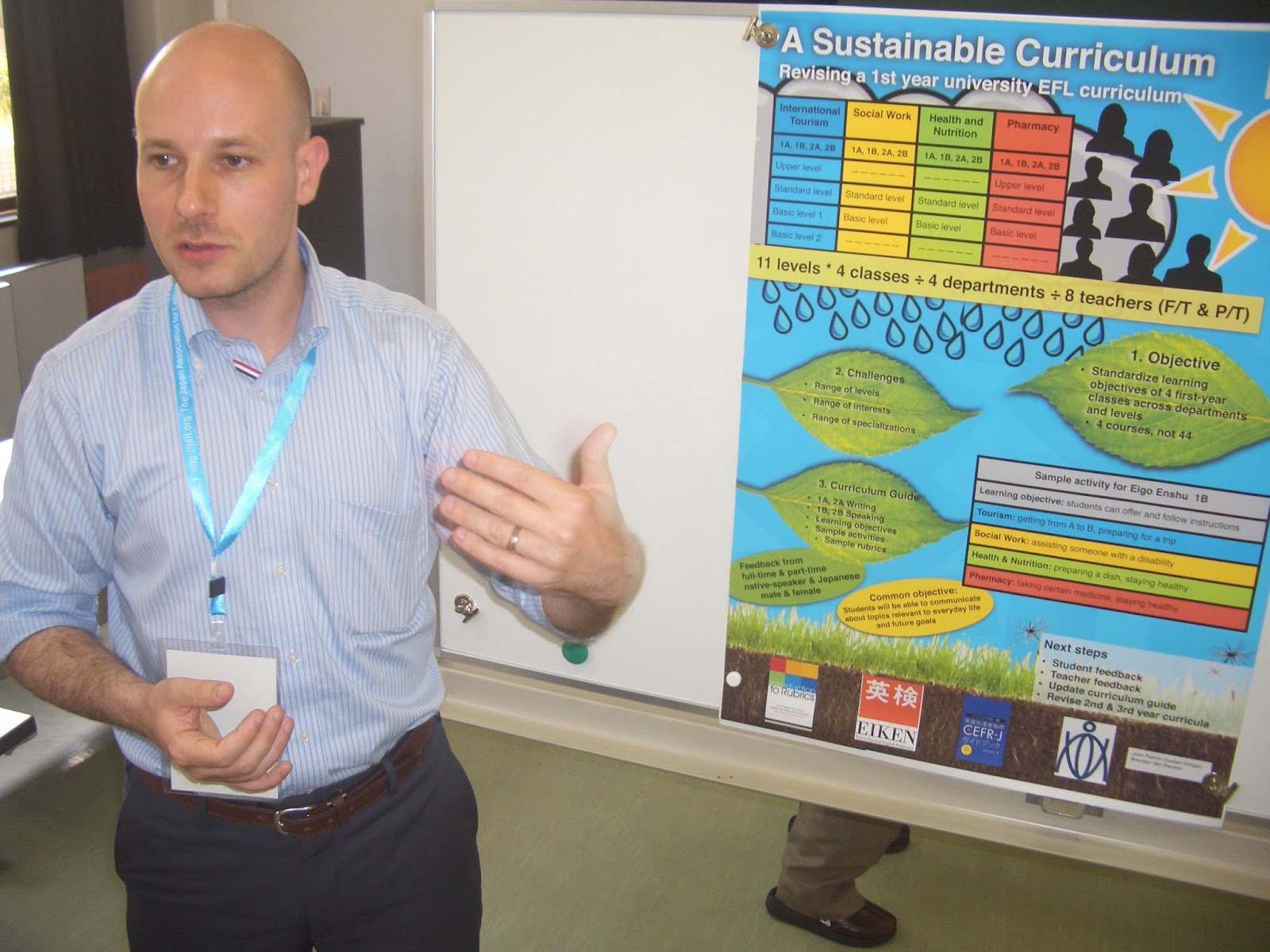 |
| Karen Masatsugu presents a short study abroad project. |
This year's PanSIG format involved a plethora of poster-style discussion groups and forums. There were also some interesting plenary speaker sessions. Although I didn't participate directly in the conference as a presenter, the close quarters and discussion-centric style made for thought-provoking discourse - I was able to take in quite a lot over a short period of time. Here enclosed are some notes and images from the weekend.
----- Brendan Van Deusen & J. Patrick Dorgan's Poster Presentation -----
Karen presented on sustaining a short study abroad program. Three weeks home stay in Australia with CQ University in rockhampton. She is finding a lot of interest from attendees who visited her presentation and has received a few new ideas for her own program. She talked to us about the challenges, successes and difficulties in the 7 years of organizing the program.
----- Plenary Speaker Hideo Nakazawa -----
The first plenary speaker was Professor Hideo Nakazawa from Tohoku.His talk focuses on the Tohoku disaster and the ongoing recovery and revitalization efforts. He discusses the failure of the revitalization efforts and the disappointment felt by the Japanese people.
After the disaster, there was formed a Reconstruction Design Council with a theme of "Hope Beyond the Disaster". It was a chance for Japan to move into a new way of managing people and country given the opportunity for rebuilding lives. However, without grand designs the government moved forward with expensive land reclamation and seawall projects. There is no focus on the people who were displaced.
Rikuzentakata city - the city plan is to fill in with soil taken from nearby mountains and rebuild from scratch. The seawall project where the government is even making a wall protecting a mountain. Construction continues while human care is failing. People are barely being cared for by NGOs.
At this phase of Professor Nakazawa's talk, he gives us time to discuss amongst ourselves these things. We discussed as a large group broken into smaller pairs, threes, and fours on our own and things were lively.
2nd part of the talk - institutional inertia
Hurry up philosophy is built into the law since the 1950's. No time is used for environmental assessment. The Article 11 financial law in Japan states that all taxes collected in a year should be exhausted before the end of the fiscal year.
Tsunami and the Village - 1943 - Yaichiro Yamaguchi's proposal for preparatory action by relocation was not realized due to WWII outbreak. Kesennuma City - Seawall issue - Residents trying to resolve stalemate with the government.
3rd part of the talk - role for education.
Basically educate everyone on these things to prevent an emotional response to these disasters. Emotional constructionism. Kamaishi's miracle - students escaped from the schools by reacting to the situation as it happened. They didn't stick to their original plan and because of that were spared. They also saved many neighborhood people due to their noise as they evacuated. They wrote about their experiences and Learner SIG helped work on a project to translate it.
Historical self-image of Tohoku is very low - comments made of the area over the centuries have been humiliating. However an All-Japan team has come to the area and there is a chance for metamorphosis of these images to something better. One example, Ancient Futures, LTD - Michihiro Kona - Yagisawa Soy Sauce Company who lost everything in the disaster is working to help the people.
----- Plenary Speaker Paul Hullah -----
Paul Hullah - On Sustenance and Betterment in Language and Literature and Learning and LifePaul's presentation championed the use of literature in the EFL classroom. He battles "literaphobia" - the preconceived idea that literature is difficult and bad and unwelcome. His talk ambled through many points and ideas on this theme and generated a lot of discussion afterwards. Some points I noted:
John Keats - we distrust literature that has designs on us
He is also discussing the importance of literature - defined on his website http://libalit.com by Paul himself.
A Haiku Paul showed us:
To express oneselfHe is covering how poetry is often viewed as too difficult for students, yet running some poems through the 3000 most common English words there are some good poems that fall in the 90% readability scale. Also, teaching students how a text can be interpreted in many ways allows for a kind of growth in language learning that is beneficial in ways a traditional text is not. For example, opening the minds of students to make choices in life and to teach them that they do have choices and the choices belong to them.
In seventeen syllables
is very diffic
Some additional photos I took.































No comments:
Post a Comment